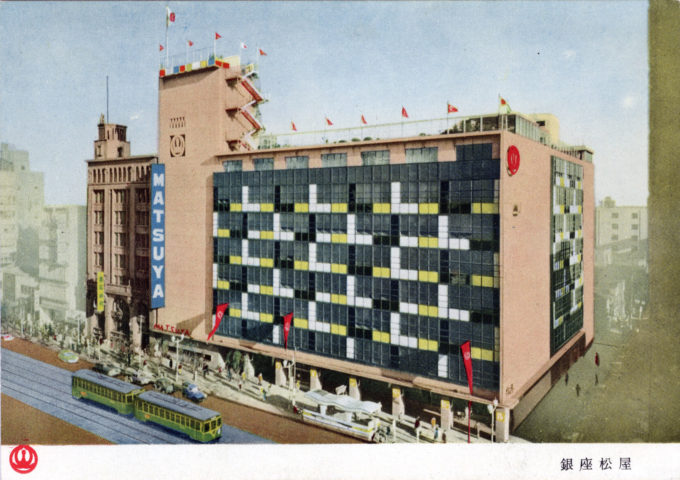See also:
Matsuya Department Store & Tobu Railway, c. 1930
Japanese Department Stores, c. 1930.
“The department stores located along the stretch between Nihonbashi and the Ginza attracted people from both near and far, and their very presence contributed to the hub of activity and crowds of people. What really contributed to the area’s popularity, however, was the decision by Matsuzakaya to set up a Ginza branch in 1924, and by Matsuya in 1925.
“… People thronged to see and be seen, as Matsuya in particular decided to push the Ginza name as part of its trend-setting marketing strategy, and the Ginza became the centre of fashion. As part of its strategy Matsuya bought up copies of two hit records (‘Tokyo Parade’ and ‘Ginza Serenade’) which it then distributed to local tea houses and bars which were rewarded if the records were played during store employees’ random visits.”
– Asian Department Stores, by Kerrie L. MacPherson, 2013
- Interior view, Matsuya department store dining room, Ginza, c. 1940.
- Matsuya department store, Ginza, c. 1935.

Aerial view of Ginza Crossing, c. 1940. The Wako (Hattori) clock tower is left of center; Matsuya department store is at top center; Matsuzakaya department is at bottom center.
Matsuya & Co. was founded in 1869, in Yokohama, as Tsuruya Gofuku-ya. In 1889, the company acquired not only Matsuya Gofuku-ya, a ceramics and chinaware shop located in the Kanda district of Tokyo, but also its name. The original Kanda location was expanded in 1907 into a three-story structure, considered by some to be the first true department store in Tokyo. Matsuya opened its department store near Ginza Crossing in 1925, while also opening a branch store at Asakusa in 1930.
In 1927, Matsuya Ginza “invited” American dolls to a Hina-matsuri [doll festival]. More than 12,000 blue-eyed dolls accepted the invitation, and it took several boat crossings by steamship before all of the dolls were collected. Each of these doll messengers carried a little passport, just like a real American passport, signed by the Japanese Consul-General in New York, and a tiny ticket to Japan, and also a message of from 150 to 200 words signed by the American children who had shared in the enterprise. At the reception ceremony for the dolls held in a primary school auditorium, over 2,000 children attended, with even more children overflowing onto the wharf. The festival represented a high-point in pre-war relations between Japan and the United States. Then-US Ambassador to Japan, Charles MacVeagh, remarked at the time:
“When you see and touch those dolls, you will find in every part of them evidences of the loving thought and sympathy with which they were made and dressed, and I am sure you will accept and treasure them in the same spirit in which they are offered; and I am equally sure that today will go down in the annals of history as one which has greatly helped to forge the chain of complete understanding and friendship between America and Japan, which, by the grace of God, shall never be broken.”
- Matsuya department store, Ginza, c. 1930.
- Ginza Crossing, c. 1950, looking toward Kyobashi. At top-right is the Matsuya department store. The vertical red sign reads “Tokyo PX”.
MacVeagh’s hope for the future would go unrealized. War would break out in 1941 between Japan and the United States, resulting in Japan’s surrender and occupation four years later. The Ginza store would be heavily damaged by wartime firebombing but quickly repaired in the conflict’s immediate aftermath. Subsequently, during the Occupation period after the war (1945-1952), Matsuya Ginza would become one of the two main Tokyo PX (Post Exchanges) for Allied troops stationed in the capital and then become, during Japan’s post-war “economic miracle”, one of Tokyo’s most glamorous department stores.
- Central hall, Matsuya department store, Ginza, c. 1930.
- Central hall, Matsuya department store, Ginza, c. 1965.
The Ginza flagship branch was extensively remodeled in 1964, in time for increased tourist traffic brought by the Tokyo Summer Olympiad.











Pingback: Ginza Crossing, c. 1910-1940. | Old Tokyo
Pingback: Matsuzakaya Department Store, Ueno (c. 1907-1940). | Old Tokyo
Pingback: Post-war Ginza, 1945. | Old Tokyo
I used both stores as a PX during the occupation. Informative article except for no mention of the Yokohama Matsuya and its location and use as a PX.
Resident of Tokyo
Thank you for your insight, Arthur. The page you refer to is specific to the Matsuya department store Ginza branch. No attempt was made to make the page a complete history of the company but, rather, focus on that particular store because of the collected postcard content. There are, of course, more comprehensive histories of the Matsuya company available elsewhere on the internet.